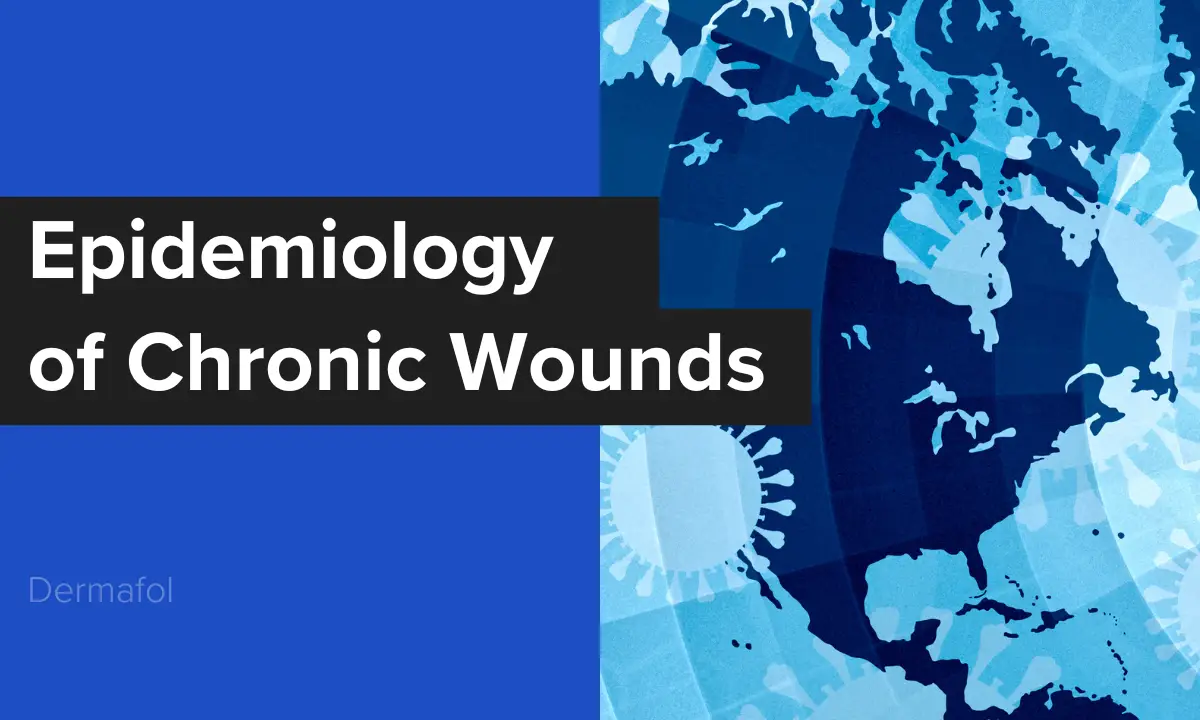Chronic wounds represent a significant global health burden affecting millions of people worldwide and imposing substantial economic costs on healthcare systems.
Despite advances in wound care management, the prevalence and incidence of chronic wounds continue to present challenges for patients, healthcare providers, and policymakers.
Here is an analysis of the epidemiology of chronic wounds, focusing specifically on venous ulcers, pressure ulcers, arterial ulcers, and diabetic foot ulcers.
Understanding the epidemiological patterns of these wounds is crucial for developing effective prevention strategies, allocating resources appropriately, and improving patient outcomes.
Burden of Chronic Wounds
Chronic wounds represent a major public health challenge with significant implications for patient quality of life and healthcare resource utilization.
According to systematic reviews, the pooled prevalence of chronic wounds of mixed etiologies is estimated at 2.21 per 1000 population (0.221%), while chronic leg ulcers specifically have a prevalence of approximately 1.51 per 1000 population (0.151%)1.
The true burden of chronic wounds is likely underestimated due to disparities in study designs, measurement methods, and reporting systems across different healthcare settings and countries.
The epidemiology of chronic wounds varies significantly depending on wound etiology, geographic location, demographic characteristics, and study methodologies.
Several factors contribute to the development of chronic wounds, including aging populations, increasing prevalence of chronic diseases such as diabetes and vascular disorders, and improved survival rates for conditions that predispose individuals to wound development.
The vast majority of chronic wounds identified in epidemiological studies are comprised of chronic leg ulcers, highlighting their predominance in the overall burden of chronic wounds1.
Venous Ulcers
Venous leg ulcers (VLUs) represent the most common type of chronic leg ulceration, accounting for approximately 60-80% of all leg ulcers6.
These ulcers develop as a result of chronic venous insufficiency (CVI) and venous hypertension, which lead to inflammatory processes in the lower extremities.
A systematic review and meta-analysis found a pooled prevalence of 0.32% for VLUs globally, with a pooled incidence of 0.17%2.
However, there is extreme heterogeneity across studies, which limits the meaningful interpretation of these pooled estimates.
The prevalence of VLUs increases substantially with age, with approximately 20% developing before the age of 40 and the majority occurring after age 406. In the geriatric population (aged 65 and older), the reported incidence of VLUs can be as high as 4-5%, with prevalence rates reaching up to 5% in those over 80 years of age6.
In Australia, France, Germany, Italy, Spain, the United Kingdom, and the United States combined, venous ulcers constitute approximately 80% of lower extremity wounds, with nearly 95% located in the gaiter area (between the knee and ankle)6.
Venous ulcers present a substantial recurrence challenge, with studies indicating that 50-55% of healed VLUs recur within 12 months6.
Risk factors for VLU development include previous leg injuries, deep vein thrombosis, phlebitis, obesity, and advanced age.
Approximately 40% of patients who develop VLUs have a history of deep vein thrombosis and a diagnosis of chronic venous insufficiency, while 20% of patients with venous disease also have some degree of arterial disease6.
Pressure Ulcers
Pressure ulcers (also known as pressure injuries or decubitus ulcers) represent another significant category of chronic wounds, particularly in healthcare settings such as hospitals and nursing homes.
The prevalence of pressure ulcers in nursing homes ranges from 2.6% to 24%, with an incidence of 25% among residents admitted from acute care hospitals3. In hospitalized patients, reported incidence rates vary from 2.7% to 29%, while prevalence rates range from 3.5% to 69%3.
Patients in critical care units face an elevated risk of pressure injuries, with studies reporting a 33% incidence and a 41% prevalence in these settings3.
According to the fifth National Pressure Ulcer Prevalence Survey conducted in 1999, the overall prevalence in acute care hospitals was 14.8%, with 7.1% of ulcers having developed during the current hospital stay3. Among hospital settings, intensive care units (ICUs) demonstrated the highest prevalence at 21.5%.
The largest single age group affected by pressure injuries consisted of patients aged 71-80 years, who accounted for 29% of cases3.
More recent global data from the Global Burden of Disease Study 2019 indicates that the number of prevalent cases of decubitus ulcers in 2019 was approximately 0.85 million worldwide5. The age-standardized rates of prevalence, incidence, and years lived with disability (YLDs) in 2019 were 11.3, 41.8, and 1.7 per 100,000 population, respectively.
Compared to 1990, these rates have decreased by approximately 10%, suggesting some progress in prevention and management strategies5.
At the national level, the age-standardized prevalence rates of decubitus ulcers in 2019 ranged from 1.5 to 55.2 cases per 100,000 population, highlighting significant geographic variations5. The prevalence rate of decubitus ulcers increases with age, reaching its peak in the over-95 age group among both men and women.
Additionally, a positive correlation exists between age-standardized YLDs and the socio-demographic index (SDI) at the regional and national levels5.
Arterial Ulcers
Arterial insufficiency ulcers, also known as ischemic ulcers, account for approximately 5-20% of all nonhealing lower extremity ulcers6. These ulcers primarily result from advanced peripheral vascular disease affecting the arteries that supply the leg and foot.
Arterial ulcers typically have a distinctive “punched-out” appearance and are often located on the lateral surface of the ankle or the distal digits7.
Unlike venous ulcers, arterial ulcers are characterized by intense pain, gray or yellow fibrotic base, and undermining skin margins. Associated skin changes may include thin, shiny skin and absence of hair. Pulses are typically not palpable in the affected limb7.
The primary cause of these ulcers is inadequate blood flow to the capillary beds of the lower extremities, resulting in tissue damage that cannot be repaired due to poor perfusion.
Risk factors for arterial ulcers include atherosclerosis, hypertension, diabetes, and atrial fibrillation, all of which are more prevalent in the geriatric population6. Consequently, arterial ulcers are more common in older adults, not because of age itself, but because of the higher prevalence of vascular disease in this demographic group.
These ulcers are particularly challenging to heal without restoration of blood flow, which may be difficult to achieve in patients with multiple comorbidities6.
Diabetic Foot Ulcers
Diabetic foot ulcers (DFUs) represent a significant complication of diabetes mellitus, affecting a substantial proportion of the diabetic population worldwide. According to a systematic review and meta-analysis, the global prevalence of diabetic foot ulceration is 6.3% (95% CI: 5.4-7.3%)4.
The prevalence is higher in males (4.5%, 95% CI: 3.7-5.2%) than in females (3.5%, 95% CI: 2.8-4.2%), and higher in type 2 diabetic patients (6.4%, 95% CI: 4.6-8.1%) than in type 1 diabetics (5.5%, 95% CI: 3.2-7.7%)4.
Significant geographic variations exist in DFU prevalence. North America has the highest prevalence at 13.0% (95% CI: 10.0-15.9%), followed by Africa (7.2%, 95% CI: 5.1-9.3%), Asia (5.5%, 95% CI: 4.6-6.4%), Europe (5.1%, 95% CI: 4.1-6.0%), and Oceania (3.0%, 95% CI: 0.9-5.0%)4.
At the national level, Australia has the lowest prevalence (1.5%, 95% CI: 0.7-2.4%), while Belgium has the highest (16.6%, 95% CI: 10.7-22.4%), followed by Canada (14.8%, 95% CI: 9.4-20.1%) and the United States (13.0%, 95% CI: 8.3-17.7%)4.
Statistics indicate that 15-25% of persons with diabetes will develop a diabetic foot ulcer in their lifetime, with an annual incidence rate of 2-4%6. In the United States, diabetic-related nonhealing ulcers account for approximately 140,000 extremity amputations per year, with an annual amputation incidence rate between 0.5% and 0.8% per patient-year6.
A 10-year study found that the incidence of unilateral lower limb amputation for persons with diabetes was between 195 and 197 per 100,000 per year6.
Patients with diabetic foot ulcers tend to be older, have a lower body mass index, longer diabetic duration, and higher rates of hypertension, diabetic retinopathy, and smoking history compared to diabetic patients without foot ulceration4.
The disease burden of neuropathic ulcers disproportionately affects racial and ethnic minority groups, with Native Americans, African Americans, and Hispanics having greater rates of diabetes and its complications compared to Whites.
These groups were also reported as less likely to undergo limb salvage procedures than their White counterparts6.
Overlapping Risk Factors and Comorbidities
Several risk factors and comorbidities contribute to the development of multiple types of chronic wounds. Advanced age represents a significant risk factor across all categories of chronic wounds, with prevalence rates typically increasing in geriatric populations.
This age-related increase can be attributed to physiological changes associated with aging, including reduced tissue perfusion, diminished immune response, decreased skin elasticity, and higher prevalence of chronic diseases that predispose individuals to wound development.
Diabetes mellitus serves as a risk factor for multiple types of chronic wounds, including diabetic foot ulcers, venous ulcers, and arterial ulcers. The prevalence of arterial insufficiency ulcers among people with diabetes is particularly high due to decreased blood flow caused by arterial narrowing and the lack of sensation resulting from diabetic neuropathy7.
Similarly, cardiovascular diseases such as hypertension and atherosclerosis increase the risk of both arterial and venous ulcers.
Mobility limitations and nutritional deficiencies contribute to the development of pressure ulcers, particularly in hospitalized and institutionalized individuals.
Additionally, obesity represents a risk factor for several types of chronic wounds, including venous ulcers and pressure injuries in certain anatomical locations.
Methodological Challenges in Epidemiological Studies
The epidemiological data on chronic wounds faces several methodological challenges that limit the accuracy and comparability of prevalence and incidence estimates. Studies often employ disparate definitions of wound chronicity, with some defining it by duration (e.g., ≥3 weeks) and others using labels such as “chronic,” “complex,” or “hard-to-heal”1.
This lack of standardization complicates efforts to aggregate data across studies.
Heterogeneity in study designs, sample frames, and measurement methods further contributes to the variability in reported prevalence and incidence rates. For instance, the extreme heterogeneity observed in studies of venous leg ulcers prevents meaningful interpretation of pooled prevalence and incidence estimates2.
Additionally, the reliability of condition measurement and the appropriateness of statistical analyses used in epidemiological studies vary considerably, as evidenced by the quality assessment of studies included in systematic reviews2.
Geographic and demographic variations in healthcare access, diagnostic capabilities, and reporting systems also influence the observed epidemiological patterns of chronic wounds.
These factors must be considered when interpreting global, regional, and national prevalence and incidence estimates.
Conclusion
Chronic wounds represent a significant global health burden with substantial variations in prevalence and incidence across different wound types, geographic regions, and demographic groups.
Venous ulcers constitute the most common type of chronic leg ulceration, followed by diabetic foot ulcers, arterial ulcers, and pressure injuries, though the relative frequency may vary depending on the population and healthcare setting studied.
The epidemiological data highlights the increasing burden of chronic wounds with age, particularly in individuals over 65 years. This trend is concerning given the aging of the global population and suggests a potential increase in the overall prevalence of chronic wounds in the coming decades.
Additionally, the high recurrence rates observed for certain wound types, particularly venous ulcers, underscore the challenges of achieving long-term wound healing and the importance of effective prevention strategies.
Improving the quality and consistency of epidemiological data on chronic wounds represents an essential step toward addressing this public health challenge. Standardized definitions, measurement methods, and reporting systems would enhance the comparability of studies across different settings and populations.
Furthermore, more comprehensive data on the economic and social impact of chronic wounds would facilitate evidence-based resource allocation and policy development.
As the global burden of predisposing conditions such as diabetes, vascular disease, and obesity continues to rise, addressing the epidemiology of chronic wounds becomes increasingly important for healthcare systems worldwide.
Targeted prevention strategies, early intervention, and improved management approaches based on accurate epidemiological data have the potential to reduce the burden of chronic wounds and improve outcomes for affected individuals.
References
- https://pubmed.ncbi.nlm.nih.gov/30497932/
- https://pmc.ncbi.nlm.nih.gov/articles/PMC10588327/
- https://emedicine.medscape.com/article/190115-overview
- https://pubmed.ncbi.nlm.nih.gov/27585063/
- https://www.nature.com/articles/s41598-021-01188-4
- https://pmc.ncbi.nlm.nih.gov/articles/PMC10212749/
- https://en.wikipedia.org/wiki/Arterial_insufficiency_ulcer


